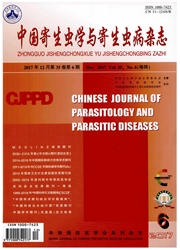

 中文摘要:
中文摘要:
为探讨粉尘螨(Dermatophagoides farinae)、屋尘螨(Dermatophagoides pteronyssinus)和梅氏嗜霉螨(Euroglyphus maynei)的分类,采用PCR扩增获得粉尘螨1类(Derf1)和2类变应原(Derf2)的cDNA片段,经测序后推导氨基酸序列,与GenBank中的屋尘螨Derp1、Derp2和梅氏嗜霉螨Eurm1、Eurm2氨基酸序列进行比对,分别构建1类和2类变应原分子进化树。结果显示变应原之间相似度,Derp1与Eurm1为86%,Derp1与Derf1为83%;Derp2与Eurm2为87%,Derp2与Derf2为67%。用变应原氨基酸序列构建分子进化树,1类变应原Derp1与Eurm1聚成一簇,2类变应原Derp2与Eurm2聚成一簇。结果表明屋尘螨和梅氏嗜霉螨亲缘关系较近,而与粉尘螨较远。
 英文摘要:
英文摘要:
Dermatophagoidesfarinae, D. pteronyssinus and Euroglyphus maynei were used for the investigation. The cDNA fragment coding for Der f 1 and Der f 2 were amplified by PCR, cloned and sequenced. By bioinformatics softwares, the amino acid sequences for Der f 1 and Der f 2 were deduced and compared with those for the groups 1 and 2 allergens of D. pteronyssinus and E. maynei available in GenBank. Amino acid sequence similarity analysis showed that Der p 1 shared 84% identical residues with Eur m l and 83% with Derf 1. Similarly, Der p 2 shared 87% identical residues with Eur m 2 and 68% with Derf2. In the two phylogenetic trees constructed with group 1 and 2 allergens, D. pteronyssinus was clustered with E. maynei but not with D. farinae, although D. pteronyssinus and D. farinae belong to the same genus. D. pteronyssinus should be more similar to E. maynei than to D. farinae at evolutional level, which was not consistent with the conventional taxonomical relationship based on their morphological characteristics.
 同期刊论文项目
同期刊论文项目
 同项目期刊论文
同项目期刊论文
 Cloning, sequence analysis, and expression of cDNA coding for the major house dust mite allergen, De
Cloning, sequence analysis, and expression of cDNA coding for the major house dust mite allergen, De 期刊信息
期刊信息
